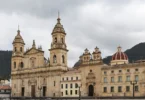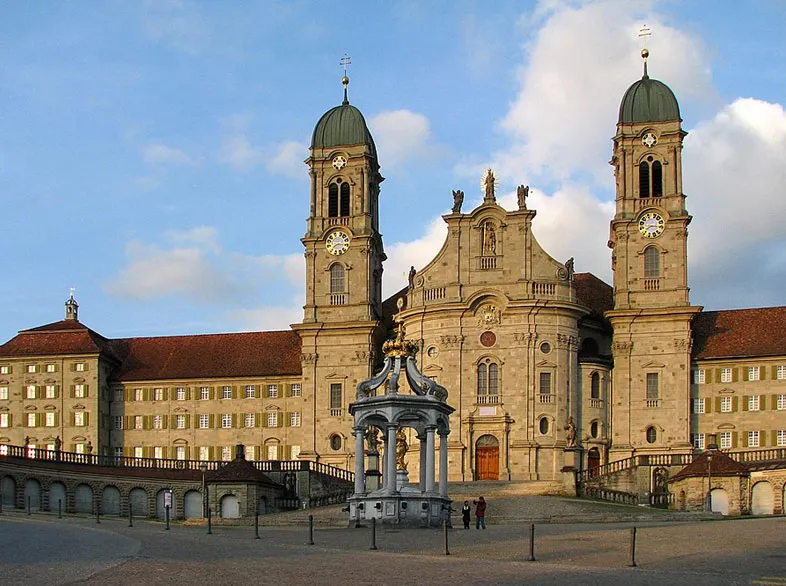
Introduction
Einsiedeln Abbey, Switzerland (German: Kloster Einsiedeln) is a Benedictine Catholic monastery in the village of Einsiedeln in the canton of Schwyz, Switzerland. The abbey is dedicated to Our Lady of the Hermits, in recognition of Meinrad of Einsiedeln, a hermit saint. A territorial abbey, Einsiedeln is not under the jurisdiction of a diocese or a bishop.
Einsiedeln Abbey, Switzerland has been a major resting point for centuries for pilgrims travelling to Santiago de Compostela Cathedral in Spain on the Way of St. James.
The abbey operates a private high school along with a winery, sawmill, restaurant and other small businesses in order to support itself.
The history of the church and society is reflected in the more than a thousand years of monastery history. It shows that our monastery is not an island, but is connected to its environment in many ways. Boom and decline, idealism and decadence, holiness and sin, light and shadow alternate in the course of the centuries. And yet: What began in the 9th century with Saint Meinrad has borne fruit in many ways and has become a blessing for countless people. Our monastic community can thus build on a solid foundation in the 21st century.
History of Einsiedeln Abbey, Switzerland

The history of Einsiedeln Abbey, Switzerland starts with Meinrad of Einsiedeln. Born in 797 to an aristocratic German family, he was educated at the abbey school on Reichenau Island in what is today Germany. Meinrad became a monk and was later ordained a priest. After gaining public attention for reportedly performing miracles, Meinrad established a hermitage in 829 in the Einsiedeln forest of Switzerland, searching for privacy. He was murdered by two robbers in January 861.
Over the next 80 years, other hermits occupied Meinrad’s hermitage. In 934 Eberhard, previously Provost of Strassburg, built the Einsiedeln abbey and church on the hermitage site, becoming its first abbot. According to legend, the church was consecrated in 948 in person by Jesus Christ the Four Evangelists, St. Peter, and St. Gregory the Great. Pope Leo VIII investigated and confirmed the miracle. It was last ratified by Pope Pius VI in 1793, who confirmed the acts of all his predecessors.
In 965 Gregory, the third Abbot of Einsiedeln, was named a prince of the Holy Roman Empire by Emperor Otto I. His successor abbots would hold that title until the dissolution of the empire in 1806. In 1039, Meinrad’s relics were transferred from Reichenau Island to Einsiedeln for enshrinement. In 1274, the abbey and its dependencies were incorporated into an independent principality by Rudolf I of Germany. This gave the abbot political jurisdiction over the abbey lands.
During the early 16th century, the standards of discipline at Einsiedeln started to decline, but Ludovicus II, a monk of St. Gall who was Abbot of Einsiedeln from 1526 to 15544, restored a stricter observance. The abbey remained unaffected by the Protestant Reformation in Switzerland. Its leader, Huldrych Zwingli, had studied at the abbey for a period of time. Abbot Augustine I (1600–29) led the movement to create the Swiss Congregation of the Order of St. Benedict in 1602. Augustine established unrelaxed observance in the abbey and promoted a high standard of scholarship and learning amongst his monks.
The Einsiedeln Abbey, Switzerland was rebuilt by Abbot Maurus between 1704 and 1719. In 1779, the abbey came under control of France during its invasion of Italy, losing its status as an independent principality. In 1854, a period of unrest in Western Europe, the Einsiedeln leadership became afraid that the abbey would be suppressed or dissolved. They sent a group of monks to southern Indiana in the United States to minister to German immigrants and develop a possible place of refuge. The monks started a new foundation, now Saint Meinrad Archabbey in St. Meinrad, Indiana,
Einsiedeln Abbey, Switzerland celebrated the millennium of Meinrad of Einsiedeln in 1861. The abbey celebrated its own millennium in 1934. Pope Pius XI granted a pontifical decree of canonical coronation towards its venerated Marian image on 21 March 1934. The rite of coronation was executed by the archbishop of Milan, Cardinal Alfredo Schuster. The abbey started renovations in 1977 that were completed in 1997.
Black Madonna of Einsiedeln (Our Lady of Einsiedeln)
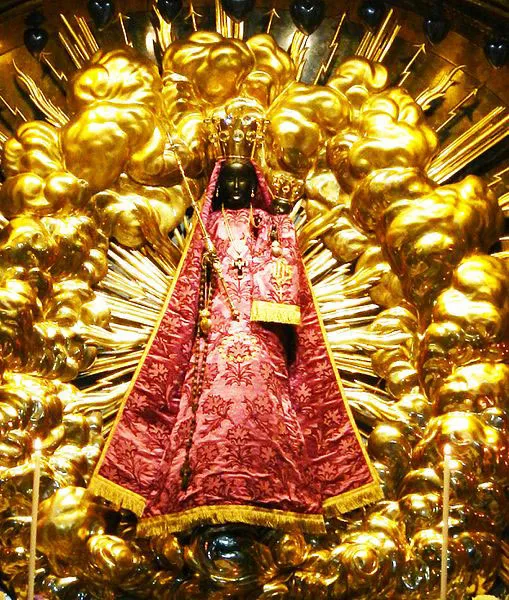
The Black Madonna of Einsiedeln or Maria Einsiedeln is a miraculous image in the chapel of grace in the pilgrimage and monastery church of the Einsiedeln monastery in the municipality of Einsiedeln in the canton of Schwyz. The Black Madonna of Einsiedeln is a late Gothic miraculous image from the mid-15th century. It replaced the originally Romanesque miraculous image, which was destroyed in the fire of 1465, and is located in the monastery’s chapel of grace.
The 117 cm high figure of Mary was carved in lime wood in the German Lake Constance area. She carries a scepter in her right hand and the naked Child Jesus on her left arm. The mother’s dark red and brown dress reaches to the floor and has gold borders. Since the figure is not wearing a cloak or veil, it can be assumed that it was created as a clothing figure. Today, the Madonna owns 27 dresses, as well as various crowns and numerous pieces of jewellery.
In 1798, shortly before the French troops marched in, the miraculous image was taken away for safety. It was first hidden nearby, then buried in the ground on the Haggenegg in the canton of Schwyz and then brought to the monastery of St. Peter in Bludenz and finally to the provost of St. Gerold. There it was restored by Adam Fuetscher. Although he found the original light skin color under the soot, he painted the skin black. It seems to be a legend that the statue with a light skin color was put back in Einsiedeln and only painted black because of the dissatisfaction of the population.
In 1803 the miraculous image was brought back to the monastery church and set up freely there. It has been in the rebuilt Chapel of Grace since 1817. A slightly reduced copy of the original can be seen today in the tower chapel at the exit of the monastery church.
The Madonna probably originally wore a veil or cloak made of fabric. In the 17th century she received a dress based on Spanish court costumes. Over time, many more dresses were given as gifts, many of them very valuable and from all over the world. Sceptres, clothes, crowns and jewelry are called “hangings of Our Lady of Einsiedeln”. The curtain is changed according to the church year.
History of Black Madonna of Einsiedeln
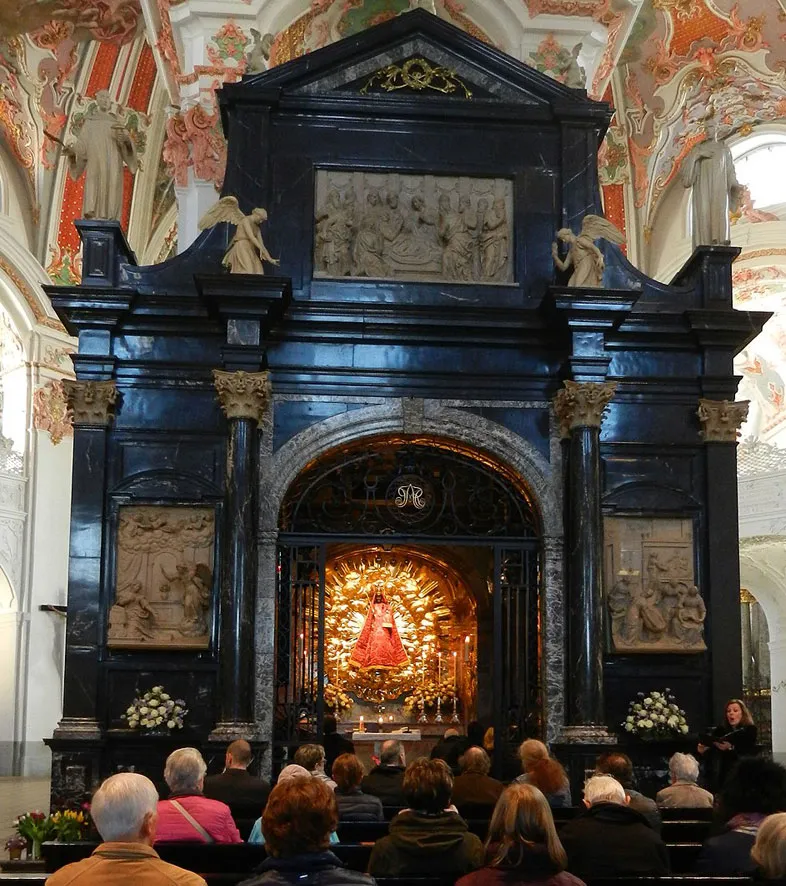
The image, carved in the soft late Gothic style, was created between 1440 and 1465 in southern Germany; it is attributed to the circle of Hans Multscher or to the early workshop area of Multscher in the circle of Hans Striegel the Elder. The 117 cm tall, slender figure of the Virgin Mary made of linden wood, slightly curved to the left, wears a crown, holds a scepter in her right hand and carries the crowned Infant Jesus on her left arm, who holds a bird with his left hand and gives the blessing with his right.
The boy Jesus is naked, the figure of the Mother of God wears a strawberry-red dress imitating damask, which is held together under the breast by a belt and falls in radiating folds. The now black face and black hands of the Madonna, like the Infant Jesus, were originally painted. They became dark over the decades, eventually silver-black, due to the smoke and soot from the many candles and oil lamps that were constantly burning in the cramped and dark Holy Chapel. As early as the 17th century people simply spoke of the “Black Madonna of Einsiedeln”.
Shortly before troops from General Schauenburg occupied Einsiedeln on May 3, 1798 in the wake of the French Revolution and the old Chapel of Mercy was demolished in mid-May, the miraculous image was brought to safety. First hidden in the Alpthal and shortly afterwards buried in the ground on the Haggenegg for a few weeks, the miraculous image managed to escape to Vorarlberg, to the monastery of St. Peter in Bludenz and then to the provost of St. Gerold.
In St. Gerold, the statue was restored and partly repainted by the Ludesch barrel painter and ornamental painter Johann Adam Fuetscher. Since the summer of 1799, the skin of mother and child has been completely black. In 1803 the “Black Madonna” was able to return to Einsiedeln and has been in the newly built Chapel of Mercy ever since.
Initially, the Madonna of Einsiedeln probably wore only a cloak draped as a veil. Since the 17th century, the Madonna of Einsiedeln has been wearing a dress in the Spanish court costume, which only leaves the face and hands of the Gothic figure and the Jesus child uncovered. The individual Madonna dresses, 27 in number, are called, together with the sceptre, crowns and the changing jewelry, “Hangings UL Frau von Einsiedeln”. The retention of the ceremonial regalia is hardly questioned today.
The magnificent, stylized robes, together with the veil, which reaches down to the hem of the dress and gives the miraculous image the outline of a triangle, create a majestic distance and yet allow the mother and child an intimate human closeness and intimacy.
Black Madonna of Grace
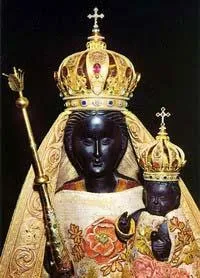
It is striking that all Black Madonnas have been worshiped as images of grace since time immemorial. However, it is not the black color that makes them a miraculous image, but they are black because the believers worshiped them as miraculous images. There are further attempts at explanations from comparative religious studies, esotericism, analytical psychology according to CG Jung and feminist theology.
Some of these are definitely worth considering and illuminate the complex phenomenon of the Black Madonna from different sides, some of which are unfamiliar to us. It goes without saying that caution is required here and no false conclusions may be drawn. The Black Madonnas are Catholic cult images and so we are guided by the faith and tradition of our church. But dealing with other explanatory models is important and helpful, especially in the context of the Black Madonnas.
Here in Einsiedeln, the late Gothic, 117 cm high linden wood statue from the middle of the 15th century has become relatively unspectacular to the Black Madonna. This becomes clear from the restoration report written by the Vorarlberg painter Johann Adam Fuetscher in the autumn of 1799. There it says:
«The face was completely black: but this color is not to be attributed to the brush, but to the vapor of the lights and traffic lights, which have always been on in the H. Capell in Einsiedeln for so many centuries: for I found and saw it evidently that the complexion of the face was initially quite flesh-colored, as can be clearly seen from the fallen crusts, which are still preserved.»
Why did the miraculous image have to be restored? On its escape it was briefly buried on the Haggenegg between Alpthal and Schwyz. The wooden statue didn’t do well with the damp soil. After the miraculous image was brought to the Dominican monastery of St. Peter near Bludenz by the monastery conductor Placidus Kälin, disguised as a peddler, the damaged statue was carefully restored. Fuetscher again:
“After I removed everything that was easily soluble and discolored from the face, but smoothed out the solid parts of the color as much as possible, I then painted the whole face of both the mother and the child with a black color similar to the previous one […].”
Black Because A Miraculous Image
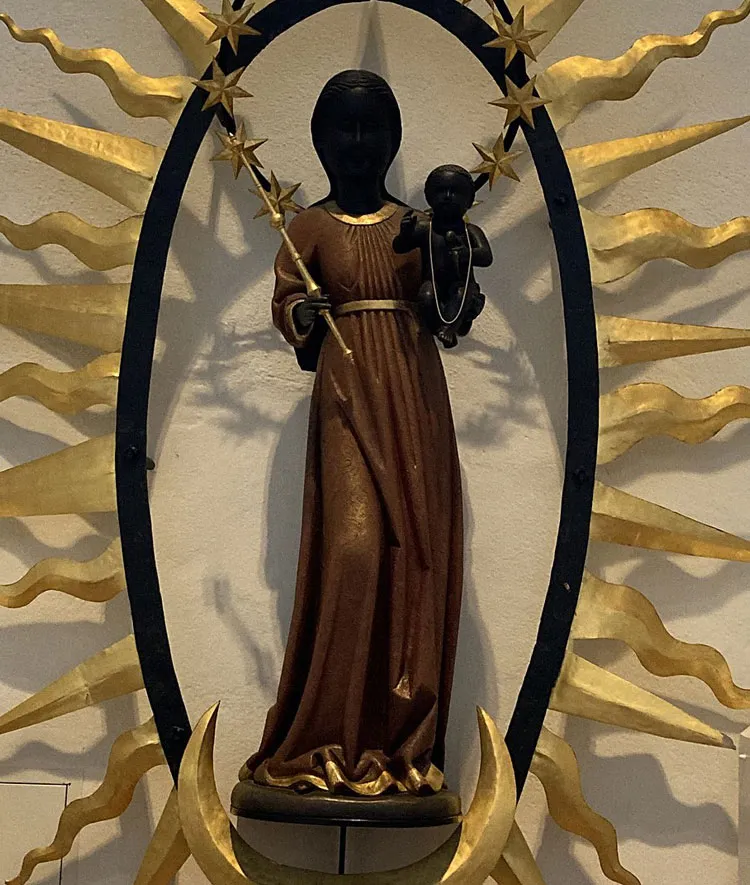
It is interesting that the Black Madonnas gained popularity just as art was becoming more naturalistic. The black color made it clear that the statue of the Mother of God in question was not an art object that wanted to please, but a window into a transcendent world. Therefore, the Black Madonnas of the West are also similar to the icons of the Eastern Church.
In addition, it is also noticeable again and again that the miraculous images in the Catholic Church – whether Black Madonna or not – seldom correspond to the classical ideal of beauty in art. Often there are pictures and statues by unknown artists. As beautiful as Raphael and Michelangelo’s depictions of the Madonna are, none of them have become sacred images. Only the simple testimonies of Christian art are worshiped.
But this is exactly what makes them transparent to those they are supposed to represent: the Virgin Mary, Mother of God. The humble woman from Nazareth, chosen by God to be the mother of his Incarnate Son, seems to have a taste for the simple, the plain and the discreet.
The black color in the face should obviously support this. The “hangings” that used to be obligatory for the venerated miraculous images, but are still widespread today, also point in this direction. With the rigid, enveloping textiles, the artistic appeal also receded into the background.
We know next to nothing about the predecessors of the current late Gothic miraculous image of Einsiedeln. Certainly there was a portrait of the Virgin Mary in the “Hermit Chapel” early on. Especially after the patronal change from the Redeemer to the Marienkapelle in the 12th/13th In the 19th century, such a thing was really necessary. It is probable that this was a Romanesque seated Madonna and Child, analogous to the Romanesque figure of Mary that is now in Einsiedler’s private collection. The convent seal from the 13th century also shows a seated Madonna, but this cannot necessarily be linked to the statue in the Holy Chapel.
However, the current figure of Mary has a clear model: the “Maria in the dress of corn”, which was highly venerated in southern Germany and Lombardy in the 15th century. It is not known where this depiction originally came from. But in Milan Cathedral, such an image was highly venerated by the faithful, especially by the German colony living there.
The depiction of Mary without a cloak characterizes her as a virgin, more precisely as a “temple virgin”, as the youthful mother of Jesus is depicted in the apocryphal Gospel of St. James. The well-known art historian Linus Birchler (1893 – 1967) summarizes the connection between the miraculous image of the hermit and the “Madonna in a dress of corn” as follows:
«The unknown carver of the Hermit Madonna or his adviser was, in my opinion, unmistakably inspired by the shaping of the Madonna of Grains, and the dominant train of thought was this: The Madonna of Grains represents the Temple Virgin; when the hermit Madonna leans formally close to the Maiden of Grains, but carries the little child on her left, forward arm, it is obvious to the worshipers that the Virgin and Mother are clear.” Thus, the hermit miraculous image combines two Marian beliefs of the church: the motherhood of God and her perpetual virginity.
The Spiritual Message of the Black Madonna
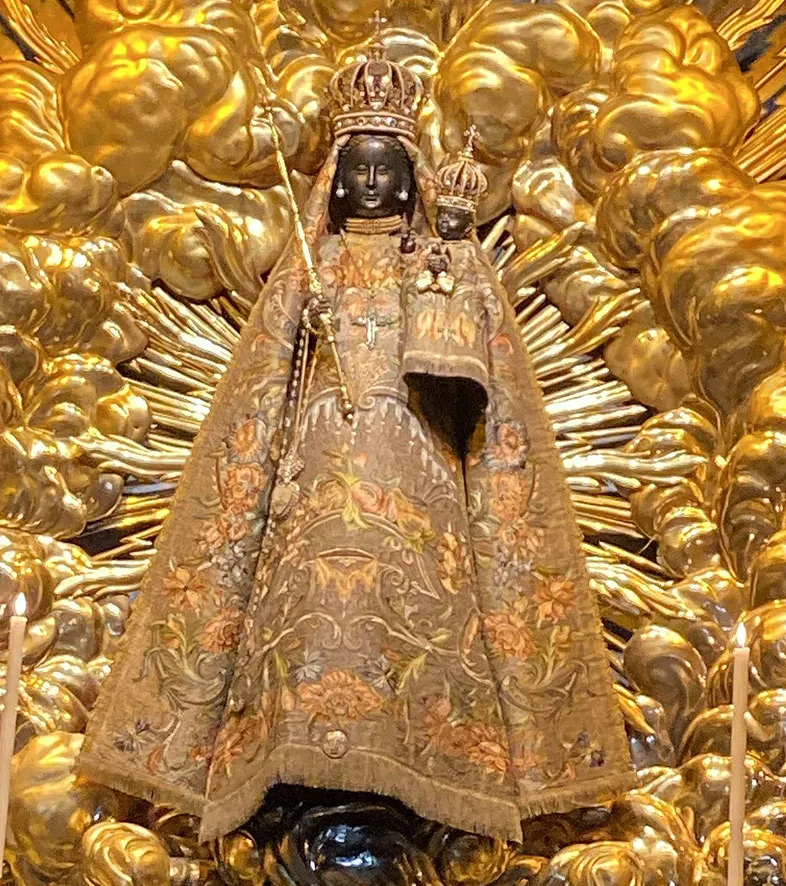
Father Martin Werlen offered a very good explanation of the miraculous image and its spiritual message in his sermon on the Solemnity of Our Lady of Einsiedeln in 2017. He drew attention to the fact that Jesus Christ, not Mary, is the main character in the miraculous hermit image. Jesus is in the center.
Father Martin quoted a verse from the Song of Songs, from which the 2019 pilgrimage motto is taken: “Don’t look at me because I’m so black! The sun burned me” (Song of Solomon 1:6). He pointed out that the sun mentioned is understood by many saints to be Christ himself: the “sun of righteousness”. Father Martin concludes: «Whoever is close to Jesus is shaped and changed by him. Those who are close to Jesus become more and more like Jesus. Mary was closer to Jesus than anyone else.
In this way, the miraculous image of the hermit can be a “school of faith” because it teaches us anew to place Jesus at the center of our lives. We too can know that we are accepted and loved by God – with our own dark sides: We are beautiful in the eyes of God.
Chapel of Mercy
The Chapel of Mercy is located in the front part of the monastery church near the entrances, where tradition has it that the original Meinrad cell was located. It was rebuilt there after the fire of 1465. During the French invasion, the chapel was demolished so that pilgrimages could no longer take place.
In the years 1815-1817 it was rebuilt somewhat abbreviated, largely from the original materials. Large openings were made in the front and in the front part of both sides and fitted with wrought-iron grilles. During the prayers, the lattice on the front is open and allows the faithful praying in front of the chapel to see the miraculous image.
Einsiedeln Abbey Today
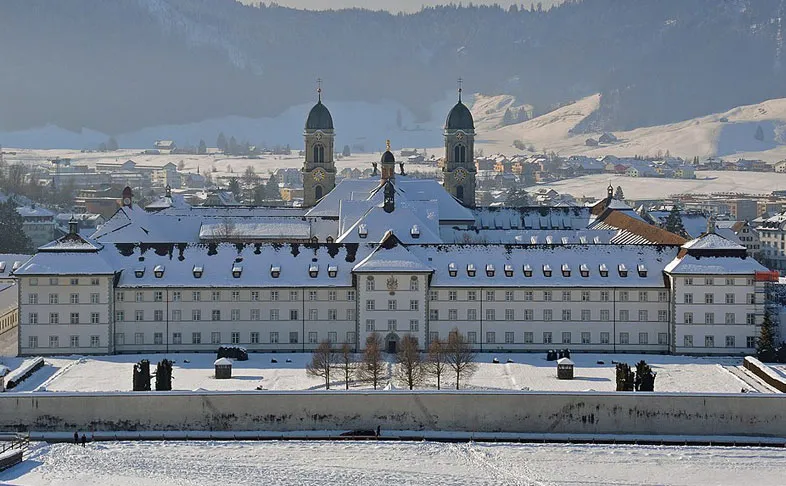
Einsiedeln Abbey, Switzerland – The pilgrimages which have never ceased since the days of St Meinrad, have tended to make Einsiedeln on a par with the Holy House of Loreto and Santiago de Compostela, serving as a major stopping point on the Way of St. James leading there. The statue of Our Lady from the 15th century, enthroned in the little chapel erected by Eberhard, is the object of their devotion. It is the subject of the earliest preserved print of pilgrimage, by the Master E.S. in 1466. The chapel is located in the great abbey church.
Today the (Einsiedeln Abbey, Switzerland) Einsiedel monastery community has around fifty monks. They are active in school, pilgrimage and parish pastoral care and do a lot of work within the monastery. The monks try to live the gospel of Jesus Christ and the rule of St. Benedict in the modern day and thus create a place that invites people to meet God here.
The community knows that it is called to serve God and the people of this place and to honor the Blessed Virgin Mary. This vocation must be lived in faithfulness and devotion. We trust that young people will also find their way into our community in the future and find happiness and fulfillment here in the service of God and of people.
Expansion to America
Five monasteries were founded in the United States by monks from Einsiedeln Abbey :
- Saint Meinrad Archabbey in St. Meinrad, Indiana
- Subiaco Abbey in Logan County, Arkansas
- Joseph Abbey in Saint Benedict, Louisiana
- Marmion Abbey in Aurora, Illinois
- Prince of Peace Abbey in Oceanside, California
One monastery, now closed, was San Jose Priory in Solola, Guatemala.
Consecration of the New Monastery Church
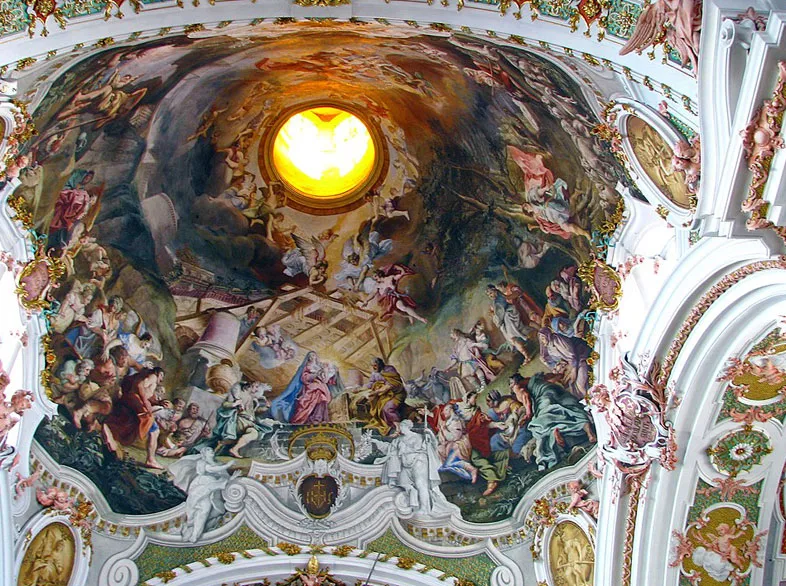
Einsiedeln Abbey, Switzerland – Ten years later, after completing the monastery building, Brother Kaspar dares to plan the new monastery church. The foundation stone for the new church was laid on July 20, 1721. The brothers Cosmas Damian and Ägid Quirin Asam, along with other important artists, were commissioned to decorate the monastery church’s interior. The monastery church is solemnly consecrated on May 3, 1735. Together, the church and monastery form a unique example of baroque architecture and still bear witness to the spirit of renewal at that time.
The library contains nearly 250,000 volumes and many priceless manuscripts. . The library contains the Versus de scachis, the earliest mention of chess in Western literature.
The work of the monks is divided chiefly between prayer, work and study. At pilgrimage times the number of confessions heard is very large In 2013, the community numbered 60 monks. Attached to the abbey are a seminary and a college for about 360 pupils who are partially taught by the monks, who also provide spiritual direction for six convents of Religious Sisters.
The monastery complex, the abbey’s library, archives and music collection are listed in the Swiss inventory of cultural property of national and regional significance as Class A objects of national importance.
Pilgrimage to Einsiedeln

Einsiedeln Abbey, Switzerland – It seems astonishing that at the same time as the internal decline of the monastery, the pilgrimage to Einsiedeln flourished. The importance of Einsiedeln as a place of pilgrimage has been linked to the legend of the so-called angel consecration for many centuries. According to this legend, Jesus Christ himself, in the company of many angels and saints, consecrated the old hermit chapel in honor of his mother Mary on the night of September 14, 948.
So people originally made a pilgrimage to the chapel sanctified by God’s presence. Over time, the focus of the pilgrimage shifted from Christ to his mother Mary, and in the course of the High Middle Ages Einsiedeln became a place of pilgrimage to Mary, to which pilgrims from half of Europe came. In 1466 the gothic miraculous image, which is still highly venerated today
Feast Day - 14th September
September 14th is the feast of Our Lady of Einsiedeln and a great day of celebration in the village.
September 14th and October 13th are the chief pilgrimage days.
- September 14th is the anniversary of the miraculous consecration of the original church in 948.
- October 13th is the anniversary of the translation of Meinrad’s relics to Einsiedeln in 1039
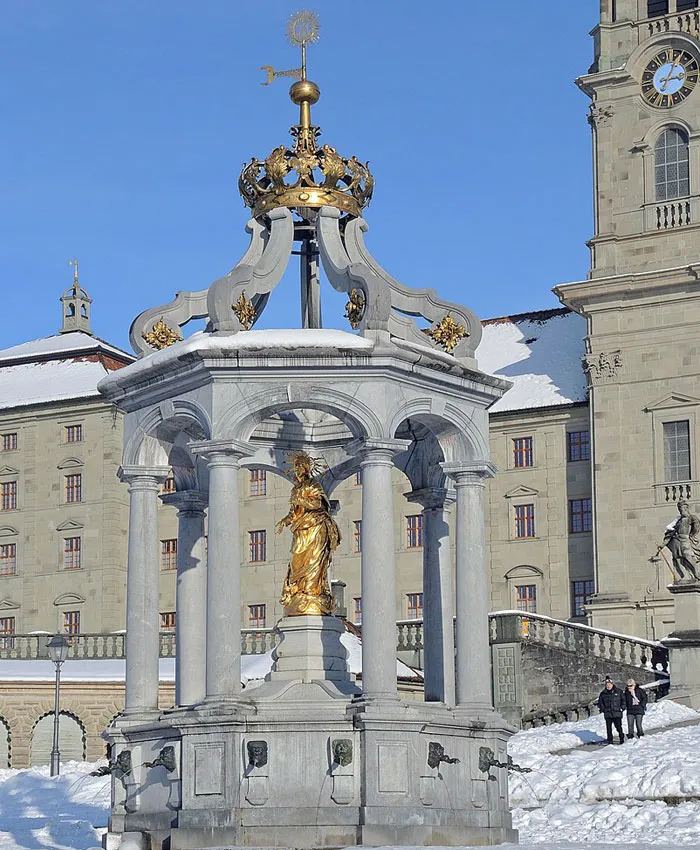
Mass Time
Weekdays
- 6:15 am, 9:30 am, and 5:30 pm (at the shrine of Our Lady)
- 11:15 am (at the main altar of the Abbey Church)
In addition to the celebration of the Eucharist, the monks celebrate the Divine Office five times a day:
- 5:30 am Vigils
- 7:15 am Lauds
- 12:05 pm Midday Prayer (only on weekdays)
- 4:30 pm Vespers and Salve Regina
- 8:00 pm Compline
Sundays
- 8:00 am and 5:30 pm (at the shrine of Our Lady)
- 9:30 am and 11:00 am (at the main altar of the Abbey Church)
Church Visiting Time
- Weekdays : 6:00 am to 8:30 pm
- Sundays : 7:00 am to 8:30 pm
Contact Info
Kloster Einsiedeln,
8840 Einsiedeln, Switzerland
Phone No.
Tel : +41 55 418 61 11
Accommodations
How to reach the Monastery
The nearest airport to Einsiedeln Abbey is Zurich (ZRH) Airport which is 38.7 km away. Other nearby airports include Basel (BSL) (105.9 km), Mulhouse (MLH) (105.9 km), Memmingen (FMM) (146.8 km) and Milan Malpensa (MXP) (166.8 km).
Arriving by Car:
Einsiedeln can be reached quickly via the A3 Zurich-Chur and A2 Lucerne-Gotthard motorways. Einsiedeln also has very good rail connections.
There are several public parking spaces in the vicinity of the monastery, as well as a multi-storey car park. The parking facilities are well signposted. There is a general driving and parking ban on the monastery grounds.
Arriving by Train:
The Zurich-Einsiedeln train journey (change in Wädenswil) takes around 50 minutes, the journey from Lucerne to Einsiedeln (change in Biberbrugg) around an hour.
The train station is about a 15-minute walk from the monastery.


